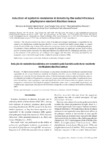Please use this identifier to cite or link to this item:
http://www.alice.cnptia.embrapa.br/alice/handle/doc/710433| Title: | Induction of systemic resistance in tomato by the autochthonous phylloplane resident Bacillus cereus. |
| Authors: | HALFELD-VIEIRA, B. de A.  VIEIRA JUNIOR, J. R.   ROMEIRO, R. da S.   SILVA, H. S. A.   BARACT-PEREIRA, M. C.   |
| Affiliation: | BERNARDO DE ALMEIDA HALFELD VIEIRA, CPAF-RR JOSE ROBERTO VIEIRA JUNIOR, CPAF-RO REGINALDO DA SILVA ROMEIRO, UNIVERSIDADE FEDERAL DE VIÇOSA HARLLEN SANDRO ALVES SILVA, INSTITUTO BIOLÓGICO MARIA CRISTINA BARACAT-PEREIRA, UNIVERSIDADE FEDERAL DE VIÇOSA. |
| Date Issued: | 2006 |
| Citation: | Pesquisa Agropecuária Brasileira, Brasília, v. 41, n. 8, p. 1247-1252, ago. 2006. |
| Description: | The objective of this work was to verify if the induced resistance mechanism is responsible for the capacity of a phylloplane resident bacteria (Bacillus cereus), isolated from healthy tomato plants, to control several diseases of this crop. A strain of Pseudomonas syringae pv. tomato was used as the challenging pathogen. The absence of direct antibiosis of the antagonist against the pathogen, the significant increase in peroxidases activity in tomato plants exposed to the antagonist and then inoculated with the challenging pathogen, as well as the character of the protection, are evidences wich suggest that biocontrol efficiency presented by the antagonist in previous works might be due to induced systemic resistance (ISR). |
| Thesagro: | Controle Biológico Lycopersicon Esculentum |
| NAL Thesaurus: | biological control |
| Keywords: | Solanum esculentum |
| Type of Material: | Artigo de periódico |
| Access: | openAccess |
| Appears in Collections: | Artigo em periódico indexado (CPAF-RO)  |
Files in This Item:
| File | Description | Size | Format | |
|---|---|---|---|---|
| 41n08a06.pdf | 125,83 kB | Adobe PDF |  View/Open |









